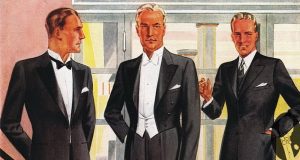Fashion has always been an important component of cultural identity, reflecting the political, social, and economic context of the day. German Fashion 1930s was through tremendous political and cultural upheavals in the 1930s, which had a big impact on the fashion industry. Despite the unstable political context, German fashion 1930s was beautiful and refined, with a distinct combination of art trends such as Art Deco and Bauhaus. The ageless nature of this style is still valued in contemporary fashion, with many modern designers drawing influence from this era. The purpose of this essay is to investigate the persistent attraction of German fashion in the 1930s, its history, and its influence on current fashion.
I. Historical background
Germany experienced enormous political and social turmoil throughout the 1930s. Following World War I, the Treaty of Versailles imposed heavy economic penalties on the country, resulting in the Weimar Republic’s economic collapse. The Nazi Party, led by Adolf Hitler, took power in 1933, ushering in a new period of political repression and authoritarianism in Germany. The Nazi dictatorship sought to establish a new national identity based on the ideas of power, order, and purity. This included exerting control over all parts of German society, including fashion.
Fashion was important in establishing German identity both before and during the Nazi rule. The Weimar Republic experienced a rise in cultural innovation, notably in fashion, during the pre-Nazi era. The time was distinguished by a distinct combination of aesthetic influences, such as Art Deco and Bauhaus, which had a significant effect on German fashion. During this time period, German designers emphasized tailoring and workmanship, as well as the use of high-quality fabrics such as wool, silk, and leather. This resulted in the development of beautiful and refined forms with sophisticated color palettes that were unique to German fashion.

However, with the onset of the Nazi government, fashion changed dramatically. Fashion was utilized as a propaganda weapon by the Nazis to promote their values of national unity, power, and purity. They imposed stricter dress standards and outlawed fashions deemed “un-German.” Fashion was used to enforce conformity, with designers obliged to make apparel that represented Nazi ideas. This gave rise to utilitarian fashion, which is distinguished by plain, functional patterns and subdued colors.
Despite the Nazi regime’s prohibitions, there was still resistance and subversion via fashion. Some designers continued to develop apparel that the Nazis did not approve of, and people found methods to express themselves via their attire. Even after the Nazi dictatorship fell, German fashion designers attempted to recreate the grace and splendor of pre-Nazi dress. Today, the timeless charm of 1930s German dress continues to inspire designers and fashion fans worldwide.
II. Characteristics of German fashion in the 1930s
German fashion in the 1930s was characterized by a unique blend of art movements, such as Art Deco and Bauhaus, which heavily influenced its style. German designers during this period focused on tailoring and craftsmanship, and there was an emphasis on using high-quality materials like wool, silk, and leather. These materials were sourced locally, which gave German fashion a distinctive character.
The silhouettes of German fashion in the 1930s were elegant and sophisticated. Dresses were fitted at the waist and featured full skirts that fell just below the knee. Evening gowns were more fitted and featured daring necklines and bare shoulders. These silhouettes were designed to enhance the natural curves of the female body, and the use of high-quality materials added to the luxuriousness of the garments.
The color palettes of German Fashion 1930s were sophisticated and elegant. Neutral shades, such as black, white, and gray, were popular, as were bold jewel tones like emerald green and sapphire blue. Prints were also popular, and designers used geometric shapes and floral patterns to add interest to their designs.
Accessories were an essential part of German Fashion 1930s. Women wore hats, gloves, and scarves to complete their outfits, and shoes were typically heeled and made from high-quality leather. Jewelry was also popular, and women wore necklaces, earrings, and bracelets made from precious metals and gemstones.
Overall, German Fashion 1930s was characterized by its timeless elegance and sophistication. The emphasis on tailoring and craftsmanship, along with the use of high-quality materials, gave the garments a luxurious feel. The use of neutral color palettes and bold jewel tones, along with intricate prints, added interest to the designs. Accessories played an essential role in completing the outfits, adding a touch of glamour and refinement.
III. Fashion icons and designers of the 1930s
Several fashion stars and designers rose to prominence in the 1930s, helping to influence the German fashion industry. Elsa Schiaparelli, an Italian-born designer who established herself in Paris in the 1920s, was one of the most recognized individuals. Schiaparelli was recognized for her avant-garde designs that used bright colors and strange materials like cellophane and aluminum. Many celebrities, like Marlene Dietrich and Mae West, wore her designs.
Coco Chanel, who had already established herself as a major designer in the 1920s, was another notable personality. Chanel was well-known for her elegant, fitted outfits with clean lines and little decorations. Her hallmark look comprised the little black dress, a flexible and timeless item that became a wardrobe essential for women.
Several designers arose in Germany who were influenced by the art trends of the time. Hugo Boss, who founded his fashion brand in 1924, was one of the most renowned. Boss was famous for his exquisite, fitted suits composed of high-quality fabrics such as wool and silk. During World War II, the firm became notorious for its participation in the fabrication of uniforms for the Nazi Party.
Another prominent designer was Leni Riefenstahl, who was well-known as a filmmaker and actor. Riefenstahl, on the other hand, was a talented fashion designer whose creations were worn by many famous persons of the time, including Adolf Hitler himself. Her style was distinguished by basic, practical designs that expressed utilitarian fashion.
Other renowned German designers during the 1930s were Lucie Weidt, famed for her exquisite evening dresses, and Claire McCardell, an American designer who worked in Germany at the time. These fashion giants and designers worked together to develop the German fashion industry, leaving an indelible mark on fashion throughout the world.
IV. Fashion during the Third Reich
Fashion during the Third Reich was heavily influenced by the Nazi ideology and propaganda. The regime saw fashion as an essential tool for promoting its image and values, and it sought to control the industry to ensure that its ideals were reflected in clothing.
One of the most significant changes in fashion during this period was the adoption of a utilitarian style. The Nazi regime emphasized practicality and functionality, and clothing was designed to be simple, durable, and easy to wear. Women’s clothing, in particular, was designed to be modest and functional, with skirts and dresses that were not too short or revealing.
The Nazi regime also promoted a specific aesthetic, which was intended to reflect the ideals of the regime. Clothing was often adorned with Nazi symbols, such as the swastika or eagle, and was designed to evoke a sense of national pride. Colors like red, black, and white were favored, and traditional German styles like the dirndl were promoted as symbols of national identity.
Jewish designers and fashion houses were systematically excluded from the industry, and Jewish-owned businesses were seized and liquidated. Many Jewish designers were forced to flee the country, and their contributions to the industry were largely forgotten.
Despite the efforts of the regime to control fashion, there were some instances of resistance. Designers like Lilli Wolff and Margarete Koenigs, who were both Jewish, continued to design clothing in secret, using their connections in the industry to distribute their designs. Others used clothing to express their opposition to the regime, wearing colors or symbols that were banned by the Nazis.
In summary, fashion during the Third Reich was heavily influenced by Nazi ideology and propaganda. The regime sought to control the industry to promote its image and values, and Jewish designers were systematically excluded from the industry. Despite this, there were instances of resistance, with some designers and individuals using clothing to express their opposition to the regime.
V. Legacy and influence of German fashion in the 1930s
The legacy and influence of German fashion in the 1930s can be seen in the lasting impact it had on the fashion industry. The period was characterized by a unique blend of elegance, glamour, and functionality, which would go on to inspire designers for decades to come.
One of the most significant contributions of German Fashion 1930s was the development of avant-garde design. Designers like Elsa Schiaparelli and Coco Chanel pushed the boundaries of traditional design, introducing bold colors, unusual materials, and innovative shapes. Their influence can be seen in the work of later designers like Alexander McQueen and John Galliano, who continued to push the boundaries of fashion design.
The utilitarian style favored by the Nazis also had a lasting impact on fashion. This style emphasized practicality and functionality, which would go on to inspire the development of sportswear and other casual styles. The little black dress, which was popularized by Chanel in the 1930s, would become a staple in women’s wardrobes and a symbol of timeless elegance.
The legacy of German Fashion 1930s is also evident in the work of contemporary German designers. Designers like Jil Sander, Wolfgang Joop, and Karl Lagerfeld have all drawn inspiration from the elegance and glamour of the period, creating designs that are both timeless and innovative.
In summary, the influence of German Fashion 1930s can be seen in the lasting impact it had on the fashion industry. The development of avant-garde design, the emphasis on functionality, and the timeless elegance of designs like the little black dress all continue to inspire designers today, ensuring that the legacy of German Fashion 1930s lives on.
VI. German Fashion 1930s Conclusion
Finally, the timeless aesthetic of German Fashion 1930s continues to inspire and influence designers today. Despite the turbulent historical setting, the beauty, glamour, and inventive design of German fashion have left an indelible mark on the industry.
The utilitarian aesthetic and emphasis on practicality and usefulness that characterized German Fashion 1930s have continued to influence the development of sportswear and other informal trends. The avant-garde design heritage established by designers such as Elsa Schiaparelli and Coco Chanel can still be seen in the work of modern designers who continue to push the frontiers of fashion.
Although the Nazi regime attempted to control the fashion industry, the resilience of designers such as Lilli Wolff and Margarete Koenigs, who continued to create in secret, and acts of resistance by individuals who used clothing to express their opposition, show that the power of fashion is not easily controlled.
The ongoing impact of German Fashion 1930s in the 1930s demonstrates designers’ ingenuity, invention, and tenacity throughout a difficult historical period. As fashion evolves, it is crucial to appreciate the achievements of previous designers and to draw inspiration from their timeless beauty and grandeur.
